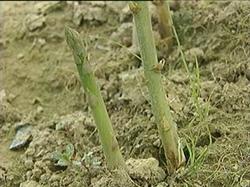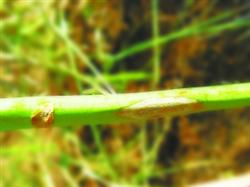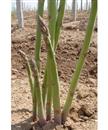Occurrence and control of stem rot of asparagus

1. Symptom characteristics asparagus stem rot mainly harms young bamboo shoots. The young bamboo shoots may be damaged after they are unearthed, and the young stems appear water-like amorphous disease spots, which expand around the stem, resulting in stem tissue disintegration and decay, resulting in the death of young bamboo shoots. If the disease is mild, even if it does not wither and die, its growth potential is greatly reduced, the aboveground stems and leaves are weak, the young stems are weak, and the yield is low. 2. Pathogen and characteristics of asparagus stem rot is caused by Pythium infection of the subphylum Pythium. The pathogen is also a kind of soil habitual fungus, which survives the winter with the remains of mycelia and oospores in the soil and saprophytic life in the soil. In the following year, the overwintering oospores can directly germinate germ tube to infect the disease, or they can germinate and produce sporangia, and zoospores can be used as the primary inoculum to infect the disease. Irrigation water and Rain Water are the main ways of transmission of pathogens, and secondly, pathogens can be transmitted by the application of soil fertilizer. A rainy year or season is conducive to the disease. Low-lying tidal wetlands, clayey soil frequently occur. There is still a lack of investigation on disease resistance among varieties. Third, prevention and control methods 1. In the areas where the disease often occurs, pay attention to the regulation of planting land drainage and irrigation system, drip irrigation can be used under certain conditions, flood irrigation should be strictly prevented, and ditches should be cleared in time to reduce dampness after rain. The clayey and heavy soil should be gradually improved by mixing sand or adding organic fertilizer to enhance soil permeability and root activity. The low-lying and moist land is cultivated with high border and deep ditch, and measures such as digging ring field ditch and cross ditch are taken to reduce the groundwater level. two。 Spray protection should be strengthened during the emergence period of young bamboo shoots. According to the requirements of no disease early prevention and early treatment, spray 30% copper oxychloride suspension agent (600 times liquid) or kill suspension agent (800 times liquid), or 25% metalaxyl wettable powder (600 times liquid), or 65.5% Prik water powder (600 times liquid), or 64% poisonous alum wettable powder (500 times liquid), 3 times 4 times, once every 5 ~ 10 days. For a small number of newly diagnosed mildly diseased plants, the spread of the disease can also be controlled by spraying young stems (50 times the liquid of the above chemicals), or mixing flour into a slurry, or adding irrigation to control the spread of the disease.
- Prev

Symptoms and control methods of asparagus stem blight
Asparagus is a kind of valuable vegetable with excellent taste. With the continuous improvement of people's living standards, the demand for asparagus in domestic and foreign markets is increasing. Because of its strong drought tolerance, asparagus is especially suitable for planting in Tianjin. However, with the increase of planting years and the expansion of the area, the occurrence of stem blight is becoming more and more serious.
- Next

Cultivation techniques of asparagus intercropping with vegetables
Asparagus brown spot is an important disease affecting the quality and yield of asparagus, which is common in many places. 1. Pathogen: asparagus brown spot is a disease caused by the infection of fungus subphyllosporium. 2, symptom identification: plant disease, stem, lateral branches and pseudo-leaves will be damaged; diseased leaves yellowing, withering, shedding.
Related
- Where is it suitable to grow horseradish in China? it is expected to see the middle altitude horseradish in Alishan.
- How to prevent tomato virus disease reasonably? (Control methods included)
- Many people like to plant towel gourd on the balcony. What are the main points of this method and management?
- What crops can chili peppers be mixed with?
- Fertilization techniques and matters needing attention in Tomato
- What are the grafting techniques for peach seedlings in spring?
- Harm and control methods of root swelling disease of Chinese cabbage
- What are the pests of sweet potatoes? How to prevent and cure it?
- Symptoms, causes and Control methods of navel Rot in Tomato
- The cause of "Cucumber rotten bibcock" in Farmers' planting Cucumber and its Control Plan

